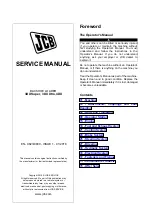
Page 51/81
April 2021
W11 - W12S -W12F - W13F - T13F | Operation manual
5.
MAINTENANCE SECTION
By definition, preventive maintenance includes regular maintenance and checking operations which should prevent
failures occurring. Preventive maintenance operations should enable the operator to discover premature wear or
deterioration of the equipment.
5.1
General cleaning instructions
For a complete cleaning of the loader, clean normally (High pressure cleaning should be avoided). Make sure
electrical components, safeties, name plates and stickers, are well protected. For electrical components, dry air of
29 psi maximum is recommended. For mechanical parts cleaning, use degreasing products and then blow air.
Batteries must be cleaned in order to prevent serious damage from chemical reactions and fault currents.
WARNING
Solvent may affect skin, eyes, and respiratory tract. Use only in well ventilated area. Avoid prolonged breathing of
vapors. Keep away from sparks and flame.
To avoid possible personal injury, never exceed 30 psi air pressure for cleaning and drying purposes. Use eye
protection with side guards and approved nozzles on air hoses.
WARNING
Loosen the fuel cap and release the reset pressure in the oil tank before disassembling the hydraulic pipe.
CAUTION
Never immerse electrical components, packing, or rubber, plastic or teflon parts in dry-cleaning solvent. Wipe parts
with a clean, lint-free cloth. Dry cleaning solvent can react with materials and result in severe damage or destruction
of parts.
•
Clean parts in a tank or spray using dry-cleaning solvent.
•
Wash cleaned parts by flushing or spraying. When necessary, use a soft bristle, non metallic moistened in dry-
cleaning solvent.
•
Dry the parts, with the exception of the bearings, after cleaning with compressed air.
•
Unless specifically called for in maintenance procedures, do not use metal scrapers, wire brushes, abrasive
wheels, or abrasive compounds when cleaning part.
•
Clean electrical parts such as relays or switches with a lint-free cloth moistened with dry-cleaning solvent.
•
Clean the heat exchanger coil by reverse flushing with a steam cleaner or with a pressure washer and soap
solution. Do not use a cleaner that will attack aluminum or copper.
•
Clean the exterior surface of the batteries with a weak solution of baking soda and water.
•
Apply the solution with a non metallic brush to remove corrosive build-up on the battery cable terminals.
•
Wash painted surfaces of the unit with a solution of 1/4 pound of soap chips to one gallon of water. Rinse with
clean water and dry with a lint-free cloth or allow to air dry.
Содержание T13-F
Страница 45: ...Page 45 81 April 2021 W11 W12S W12F W13F T13F Operation manual...
Страница 46: ...Page 46 81 April 2021 W11 W12S W12F W13F T13F Operation manual...
Страница 47: ...Page 47 81 April 2021 W11 W12S W12F W13F T13F Operation manual...
Страница 72: ...Page 72 81 April 2021 W11 W12S W12F W13F T13F Operation manual ANNEX 1 Hydraulic diagrams Hydraulic diagram W11...
Страница 73: ...Page 73 81 April 2021 W11 W12S W12F W13F T13F Operation manual Hydraulic diagram W12S...
Страница 74: ...Page 74 81 April 2021 W11 W12S W12F W13F T13F Operation manual Hydraulic diagram W12F W13F...
Страница 75: ...Page 75 81 April 2021 W11 W12S W12F W13F T13F Operation manual Hydraulic diagram T13F...
Страница 77: ...Page 77 81 April 2021 W11 W12S W12F W13F T13F Operation manual Electric diagram W12F W13F T13F...
Страница 78: ...Page 78 81 April 2021 W11 W12S W12F W13F T13F Operation manual...
Страница 79: ...Page 79 81 April 2021 W11 W12S W12F W13F T13F Operation manual...
































